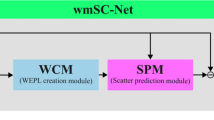Abstract
Use of a normal database in quantitative regional analysis of brain single-photon emission tomography (SPET) facilitates the detection of functional defects in individual or group studies by accounting for inter-subject variability. Different reconstruction methods and suboptimal attenuation and scatter correction methods can introduce additional variance that will adversely affect such analysis. Similarly, processing differences across different instruments and/or institutions may invalidate the use of external normal databases. The object of this study was to minimise additional variance by comparing reconstructions of a physical phantom with its numerical template so as to optimise processing parameters. Age- and gender-matched normal scans acquired on two different systems were compared using SPM99 after processing with both standard and optimised parameters. For three SPET systems we have optimised parameters for attenuation correction, lower window scatter subtraction, reconstructed pixel size and fanbeam focal length for both filtered back-projection (FBP) and iterative (OSEM) reconstruction. Both attenuation and scatter correction improved accuracy for all systems. For single-iteration Chang attenuation correction the optimum attenuation coefficient (mu) was 0.45–0.85 of the narrow beam value (Nmu) before, and 0.75–0.85 Nmu after, scatter subtraction. For accurately modelled OSEM attenuation correction, optimum mu was 0.6–0.9 Nmu before and 0.9–1.1 Nmu after scatter subtraction. FBP appeared to change in-plane voxel dimensions by about 2% and this was confirmed by line phantom measurements. Improvement in accuracy with scatter subtraction was most marked for the highest spatial resolution system. Optimised processing reduced but did not remove highly significant regional differences between normal databases acquired on two different SPET systems.








Similar content being viewed by others
References
Hoffman EJ, Cutler PD, Digby WM, Mazziotta JC. 3-D phantom to simulate cerebral blood flow and metabolic images for PET. IEEE Trans Nucl Sci 1990; NS-37:616–620.
Kim H-J, Karp J, Mozley P, et al. Simulating technetium-99m cerebral perfusion studies with a three-dimensional Hoffman brain phantom: collimator and filter selection in SPECT neuroimaging. Ann Nucl Med 1996; 10:153–160.
Muehllehner G. Effect of resolution improvement on required count density in ECT imaging: a computer simulation. Phys Med Biol 1985; 30:163–173.
Van Laere K, Versijpt J, Koole M, et al. Experimental performance assessment of SPM for SPECT neuroactivation studies using a subresolution sandwich phantom design. NeuroImage 2002; 16:200–216.
Ohyama M, Mishina M, Senda M, et al. Brain imaging using PET. New York: Elsevier Science, 2002.
Hubbell JH, Seltzer SM. Tables of x-ray attenuation coefficients and mass energy-absorption coefficients 1 keV to 20 MeV for elements Z=1 to 92 and 48 additional substances of dosimetric interest. National Institute of Standards and Technology 1995:1–111.
Hudson HM, Larkin RS. Accelerated image reconstruction using ordered subsets of projection data. IEEE Trans Med Imaging 1994; 12:601–609.
Murase K, Itoh H, Mogami H, et al. A comparative study of attenuation correction algorithms in single photon emission computed tomography (SPECT). Eur J Nucl Med 1987; 13:55–62.
Ogawa K, Harata Y, Ichihara T, Atsushi K, Hashimoto S. A practical method for position-dependent Compton-scatter correction in single photon emission CT. IEEE Trans Med Imaging 1991; 10:408–412.
Meikle SR, Hutton BF, Bailey DL. A transmission-dependent method for scatter correction in SPECT. J Nucl Med 1994; 35:360–367.
Kim KM, Varrone A, Watabe H, et al. Contribution of scatter and attenuation compensation to SPECT images of nonuniformly distributed brain activities. J Nucl Med 2003; 44:512–519.
Acknowledgements
We would like to thank Professor Ed Hoffman for providing the numerical Hoffman phantom data. Thanks also to the Department of Neurology, The Queen Elizabeth Hospital for funding support.
Author information
Authors and Affiliations
Corresponding author
Rights and permissions
About this article
Cite this article
Barnden, L.R., Hatton, R.L., Behin-Ain, S. et al. Optimisation of brain SPET and portability of normal databases. Eur J Nucl Med Mol Imaging 31, 378–387 (2004). https://doi.org/10.1007/s00259-003-1362-3
Received:
Accepted:
Published:
Issue Date:
DOI: https://doi.org/10.1007/s00259-003-1362-3




